|
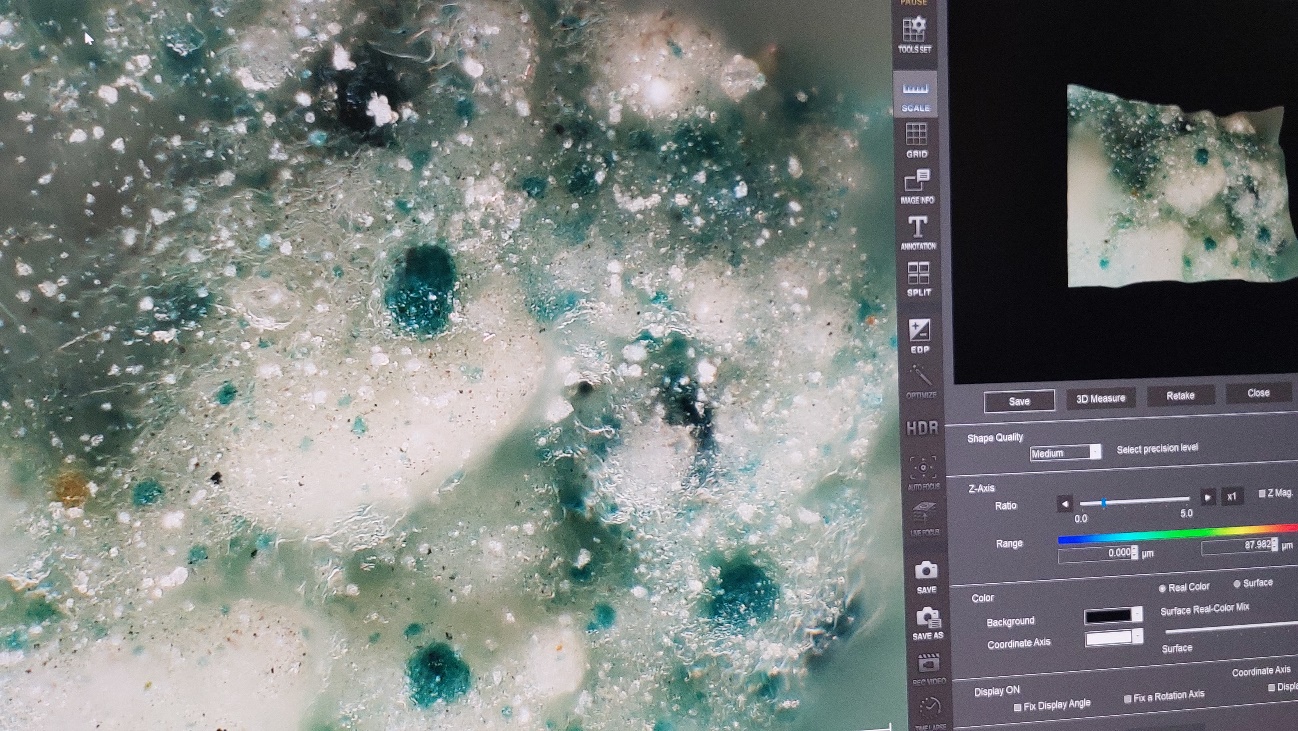
Dear readers,
We are delighted to be back in touch with you after six months of intense work in the laboratory analysing data collected from field campaigns in Portugal and abroad. And the results have been publicised in various ways. In this newsletter, the focus is on the project's publications on Almada's work, which are gradually lifting the veil on Almada Negreiros' way of operating and showing how innovative and pragmatic this artist was in the first half of the 20th century. Curious?
As always, stay with us and enjoy reading.
Image: Detail of a green colour layer with emerald green pigment, in 3D digital microscopy, 700x. ALMADA Projet©. All rights reserved.
THE PUBLICATIONS OF ALMADA PROJECT
ABOUT THE WORK OF ALMADA NEGREIROS
This paper presents the first insight into how Almada Negreiros, a key artist of the first generation of modernism in Portugal, created his mural painting masterpiece in the maritime station of Rocha do Conde de Óbidos in Lisbon. This set of six monumental mural paintings dates from 1946 to 1949 and is considered Almada’s artistic epitome. As part of the ALMADA project: Unveiling the mural painting art of Almada Negreiros, the murals are being analysed from a technical and material perspective to understand his modus operandi and the material used. This is the first study of this nature carried out on site and in the laboratory using standard and more advanced imaging, non-invasive analysis, and microanalysis techniques.
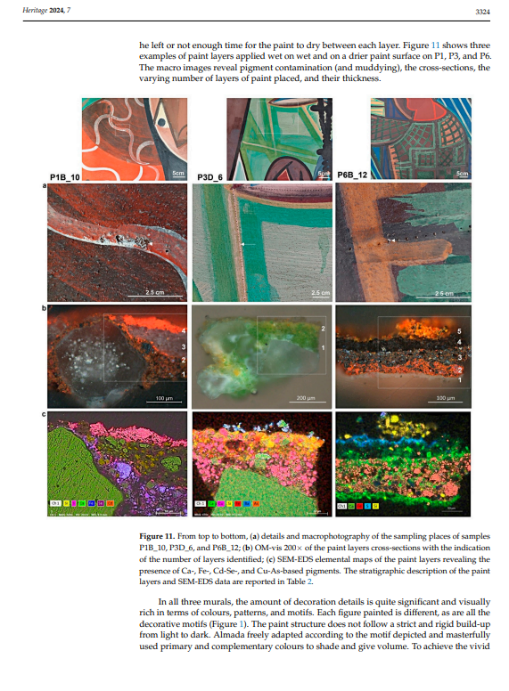
In 1949, Almada Negreiros painted at the Maritime station of Rocha do Conde de Óbidos, in Lisbon, six monumental mural paintings which are considered as his highest artistic achievement. On these paintings, he resorted to a bright colourful palette which needs to be studied to support conservation and preservation of these artworks for future generations. Among the pigments under study on project ALMADA, the identification of the green samples is the most challenging, as Almada Negreiros seems to have explored different hues by using simultaneously inorganic (e.g. emerald green, Scheele’s green and viridian) as well as organo-synthetic pigments that were rather unusual on a mural painting technique (e.g. PG7, PG8). Moreover, he seems to have admixed white (e.g. titanium white) or blue pigments (e.g. ultramarine) to modify the hues. The different colourants found, as well as the use of mixtures of pigments, hints that Almada Negreiros was keen on experimenting and applying relatively novel painting materials.
[ article available upon request]
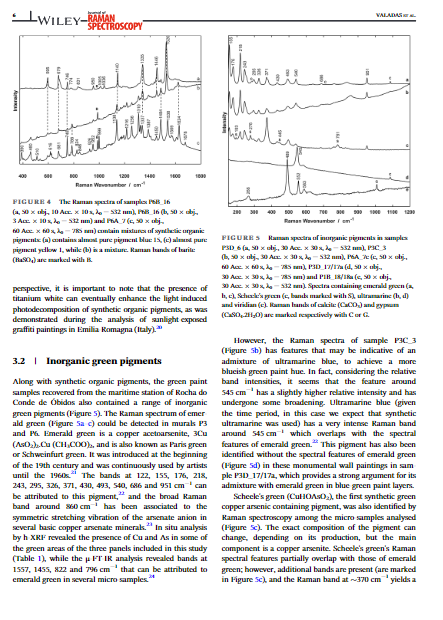
In the process of cataloguing the estate of modernist artist Almada Negreiros, many preparatory drawings for several of the author's public artworks are currently being identified. The volume and complexity of his prolific work imply that sometimes it is hard to connect specific documents and artworks of research and preparation to their respective final works. Recently, one particular drawing proved to be the key for understanding several other documents, simultaneously contributing to clarify the artist's methodology when preparing for the large-scale stained glass behind the altar of Igreja de Nossa Senhora de Fátima. This article presents these new advances. [available upon request]
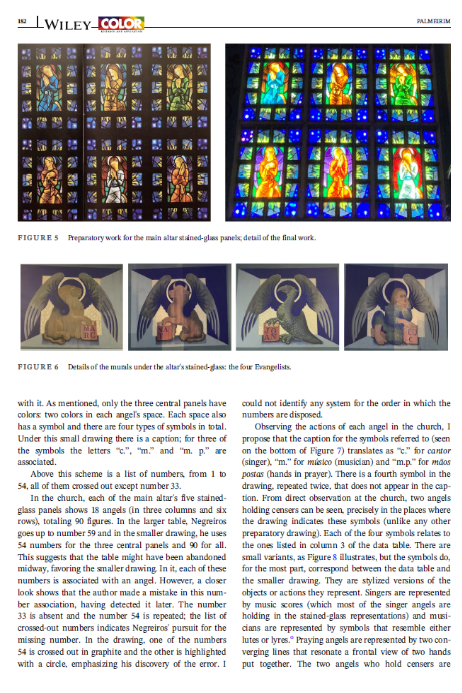
This study reports the first results of the analysis carried out in 2022 on the deteriorated green colour layers of the mural paintings by Almada Negreiros at the Alcântara Maritime Station in Lisbon (Portugal). These murals, painted in 1945, are one of the most emblematic sets of paintings by the modernist artist and have a luminous colour palette that shows different states of conservation, with the green paint layers being particularly damaged, showing strong flaking and powdering in the lighter tones. In order to understand the deterioration phenomenon, in situ and laboratory analyses were carried out to identify the green chromophores, the painting technique and the agents responsible for the anomalies present.
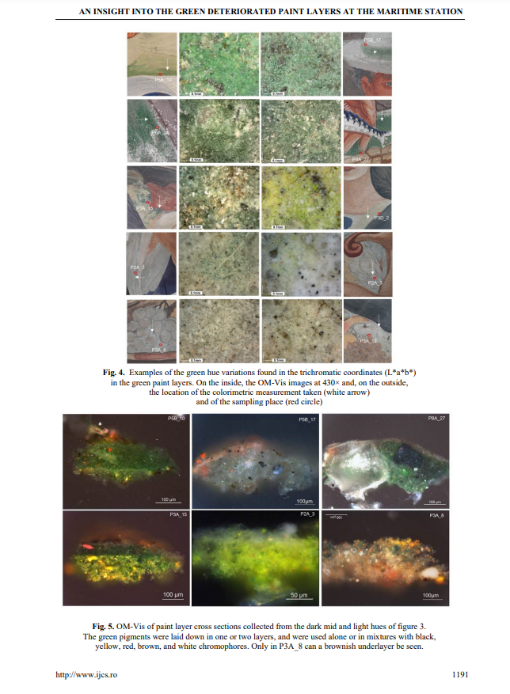
This article reports on the preliminary diagnostic survey of the six controversial murals painted in 1949 at the Gare Marítima da Rocha do Conde de Óbidos in Lisbon, considered the artistic epitome of Almada Negreiros' mural painting art. Four research questions guided this investigation: a) What are the main degradation phenomena present and their origins? b) Which paint layers are most affected and are they linked to any particular pigment? c) Is there any relationship between the painting technique used and the deterioration or stability of the paint layers and pigments? And finally, d) Are there any differences in the degradation phenomena present in the two Alcântara maritime stations?
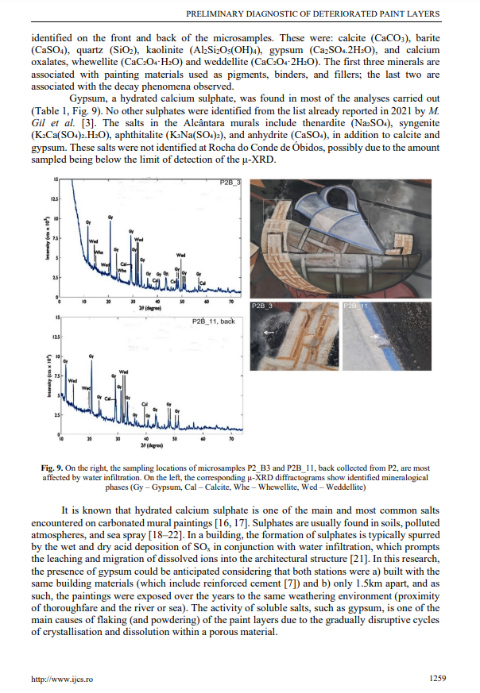
This paper presents the results of observations and analysis carried out in the modern mural painting of 54m2 , known as Planisphere (or Mapa-mundi), made by Almada Negreiros in 1939 in the city of Lisbon. The painting is Almada’s first monumental painted work at fresco, and it is a striking, colourful composition inspired by early world maps of navigators. The aim is to ascertain how he built up this masterpiece and what artistic sources could have inspired him. The data obtained was compared with the painting compendiums of Paul Bedouin’s La Fresque: sa Technique-ses applications (1914) and of Costin Petresco’s L’art de la fresque (1931), retrieved from the artist studio in 2019.
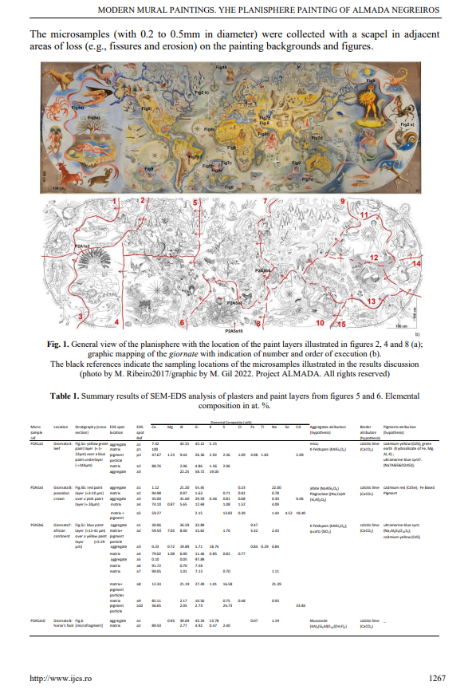
Rocha do Conde de Óbidos, dated back to the 1940s, is one of the earliest examples of reinforced concrete buildings in Portugal. Due to its vulnerability and being exposed to a quite aggressive environment, completely isolated and close to the frontline of the Tagus river, the maritime station shows severe deterioration of the structural elements, especially the ones located outside, such as spalling of the concrete cover, corrosion of the rebars, water penetration with deposit and biological growth in the joints. Moreover, there is evidence of previous interventions and repairs followed by relapse of the pathology. Due to its relevance as legacy of the architect Pardal Monteiro and the artist Almada Negreiros, key figures of the avant-garde and modernism in Portugal, an inspection and diagnosis programme has been planned and carried out by the authors. The present paper aims at presenting the preliminary results of this investigation.
[available upon request]
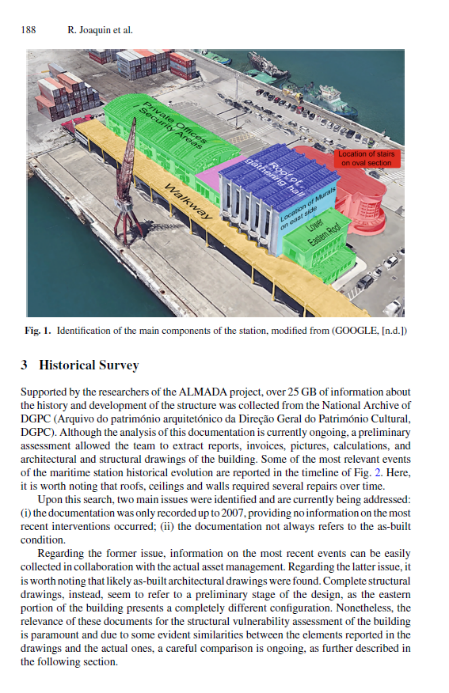
DOI: https://doi.org/10.37558/gec.v20i1
This paper reports the diagnostic research of deteriorated paint layers from three mural panels made by Almada Negreiros found in the Alcântara Maritime Station in Lisbon. The aim was to understand the main decay phenomena to aid future conservation works.
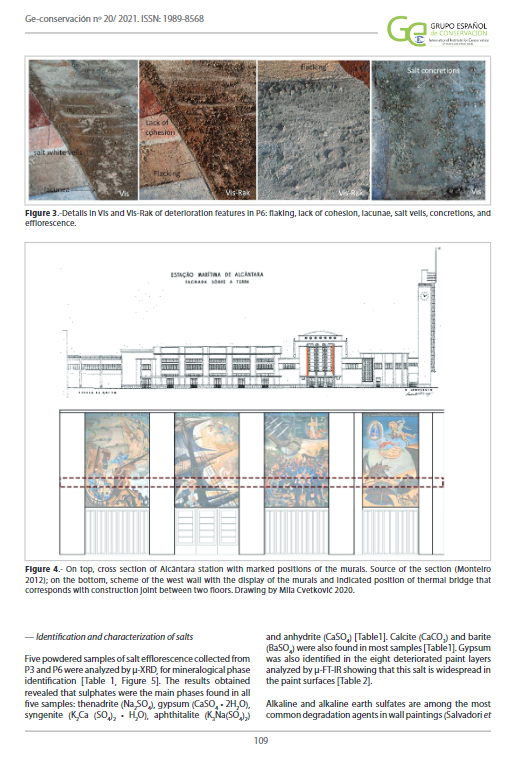
This paper reports the first analytical approach carried out on two working palettes by Portuguese modernist master Almada Negreiros, found in 1991 behind old wood cabinets at the DN building in Lisbon. This is the only known occasion Almada left behind the color experiments done before starting to paint in the nearby walls and as such, it was an unique opportunity to analyse the materials and painting techniques that were originally used.
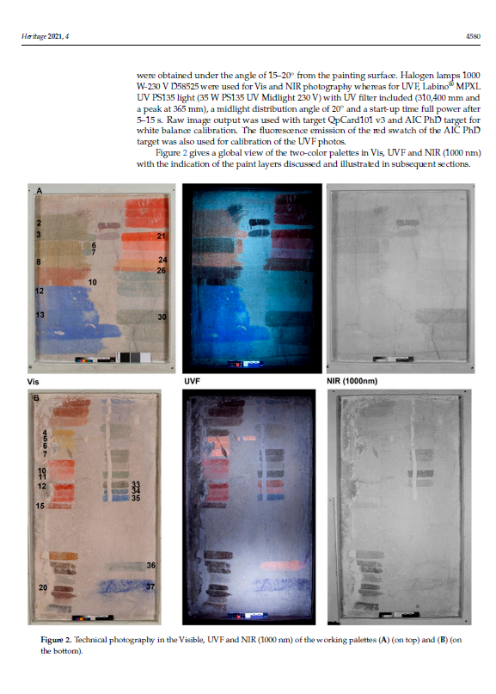
ON THE WORK OF CONTEMPORARY ARTIST OF ALMADA NEGREIROS
https://doi.org/10.14568/cp31051
Gilda Gelmini Neuberger (1911-2011), with a career spanning more than 60 years, was one of the rare artists to produce frescoes in Brazil during the 20th century. Shewas probably also the only Brazilian artist to experiment this technique on unconventional supports, as well as false frescoes with a still ambiguous meaning for the artistic community. In Brazil, the artist was a pupil of Cândido Portinari and Edson Motta and, in Italy, of Bruno Saetti. This article is based on research of primary and secondary sources, including oral testimonies from people who lived with Gilda Neuberger or knew her work. The aim is to reveal her artistic career and evaluate the potential influences of her peers in her work. The article also details the execution process and highlights the originality of her frescoes in various media, which will be analytically investigated in the future.
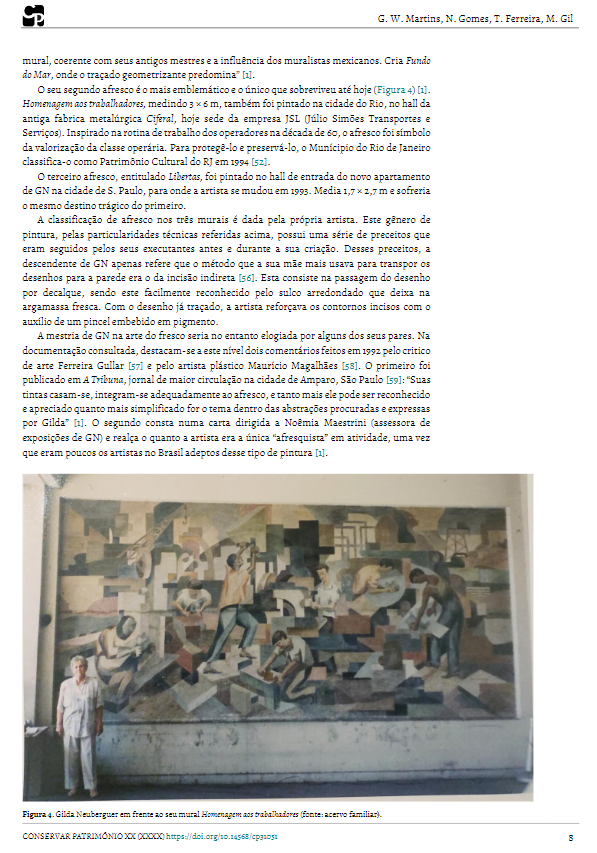
OTHERS
Tijomel was considered one of the most modern ceramic manufacturers in the Iberian Peninsula in the mid-20th century. Located at Caxarias (Ourém, Portugal), this manufacturer produced diverse ceramic-based architectural materials, from common clay bricks to sophisticated modernist azulejos. Recently members of the family of the former Tijomel Manufacture owners retrieved a collection of 33 raw materials, mostly ceramic colourants. In this study, the chemical characterisation of these ceramic colourants was performed and compared with an azulejos commercial catalogue of the same manufacturer entitled Decormel Catalogue.
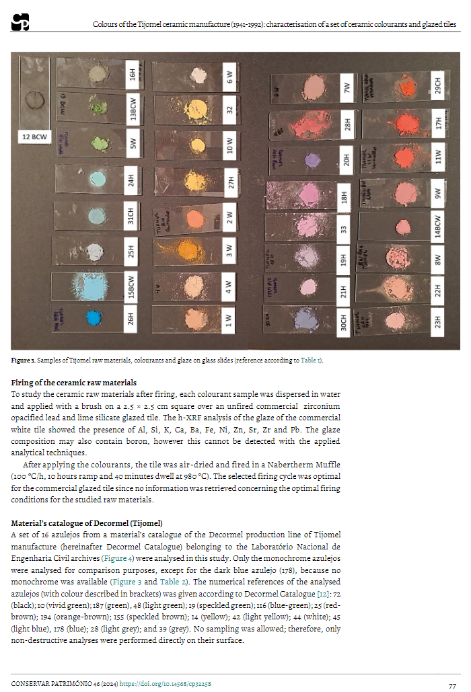
This paper reports an updated overview of a comparative study on the medium-term effects of treatment with three consolidants—laboratory-prepared nanolime, commercial nanolime, and commercial acrylic resin—on fresco paint layers replicas affected by lack of cohesion. This is a follow-up to our preliminary data published in 2021. In 2020, paint layers replicas of frescos were prepared in vitro by buon and lime fresco painting techniques with blue smalt and yellow ochre pigments. The samples were treated with the three consolidants and aged at ambient conditions. In 2023, the authors repeated the analysis to assess and compare the three-year effect of the laboratory-prepared nanolime on the paint layers with regard to the commercial nanolime and acrylic resin.
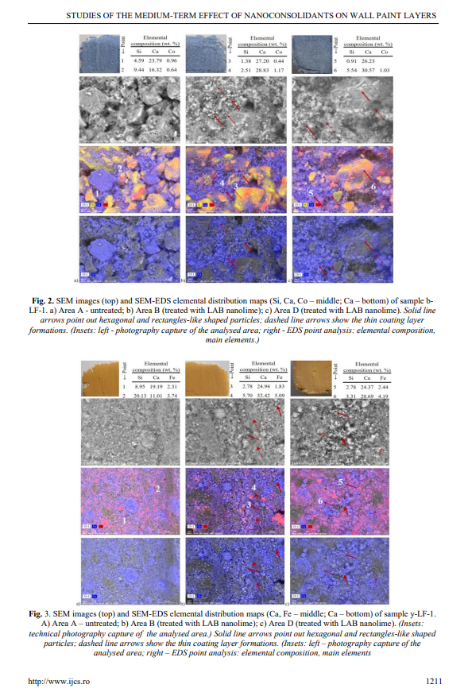
THE PUBLICATIONS ABOUT ALMADA PROJECT
- Article in the newspaper o Público about winning Europa Nostra 2023 prize. Text by Luís Miguel Queiroz.
- Article in the periodical À Segunda (issue 54) of University of Évora about ALMADA project being honoured in the Europa Nostra 2023.
- António Campos, Murals by Almada Negreiros in Lisbon. National Geographic-Portugal, October 2022 issue, pp.47-57.
Backstage photos
This section aims to show the ongoing research and its participants
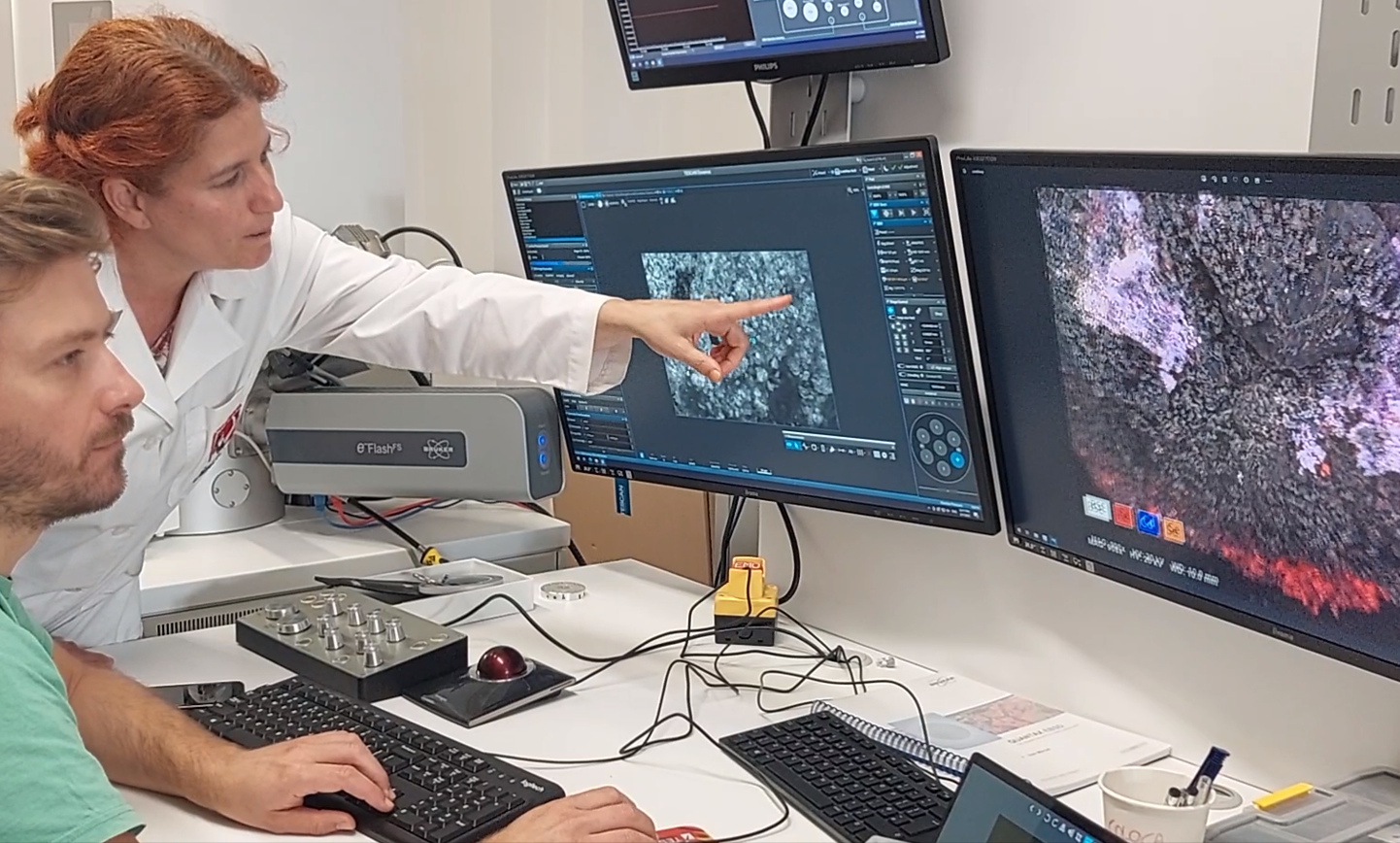
Photo: From left to right: Luis Dias and Milene Gil analysing chromatic layers with FEG-SEM. Project ALMADA2024©All rights reserved.
News published on the website
- We are hiring!
- 4th workshop hand’s of project ALMADA in Évora?
-
We are hiring!
-
Promoting ALMADA
-
Yet another good initiative at the Maritime Station of Rocha do Conde de Óbidos
-
To find out more about the paintings in Rocha do Conde de Óbidos
-
The photographer's eye. Not to be missed!
- 2023 CHRISTMAS CARD
-
THE CONTRIBUTION OF ALMADA PROJECT TO THE RESTORATION OF THE MARITIME STATION OF ROCHA DO CONDE DE ÓBIDOS
-
Another great artist of the 20th century who leaves us
-
CONSERVATION AND RESTORATION ON SIGHT - THAT'S WHAT RESEARCH IS ALL ABOUT
-
Dissemination of scientific mural painting studies at the invitation of FIOCRUZ, Brazil
-
UNVEILING OF THE EUROPA NOSTRA 2023 PLAQUE ON ÉVORA UNIVERSITY DAY
-
TRIBUTE TO ALMADA AT THE HELENA VAZ DA SILVA EUROPEAN PRIZE
-
INTERNATIONAL COLLABORATION
- ALMADA ON THE MOVE ONCE AGAIN...
Project PTDC/ART-HIS/1370/2020 financed by national funds through FCT - Foundation for Science and Technology, I.P.
The images shared in the ALMADA project newsletters are protected by copyright and may not be copied in whole or in part outside the scope of the ALMADA project without the prior authorisation of the authors and descendants of Almada Negreiros.
|
|
|

